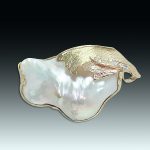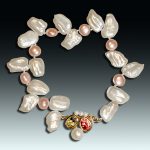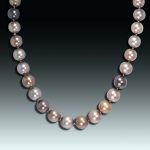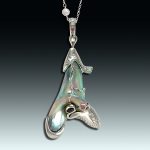
This lustrous rare natural abalone pearl inspired Eve Alfillé to create her “Calla Lily” platinum pendant in the Art nouveau style. The 14.40 carat abalone pearl is studded with emeralds, diamonds and natural alexandrite to echo the color playin the pearl. Photo by Matthew Arden, courtesy Eve J. Alfillé Gallery and Studio Evanston, Illinois.
If you haven’t noticed this month, I can’t get enough of pearls: the shapes, the colors, the sensuality of them. Probably the most romantic gemstone of them all.
Some of the most gorgeous pearls come from one of the most exotic places on Earth: Tahiti. These are some of the most striking pearls, not only for their color, but for their often immense size. The warm waters of the South Pacific means they grow quickly, and the large size of the oysters used to culture them means they can hold a much larger starter bead. They are some of the biggest pearls on the market. If you want to make a statement, go Tahitian!
Probably the best known are the gloriously iridescent black Tahitian pearls. And guys, take note. If you secretly love pearls, these are the gemstones for you! The Tahitian pearl people, many years ago, had a campaign that featured single black pearls on cords or chains for men. I have no idea why it didn’t catch on because oh, my goodness, fellows, let me tell you. That look was sex walking!
But I digress.
There are also subtly colored Tahitians: cream, gray, peach, and even chocolate.
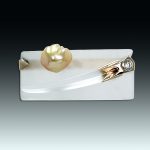
This pin, titled “Orbiting,” features a lovely carved quartz by famed lapidary Dieter Lorenz, as well as a golden South Seas pearl, all accented by a diamond and set in 14 karat gold. Photo by Matthew Arden, courtesy Eve J. Alfillé Gallery and Studio Evanston, Illinois.
But Tahitians aren’t the only heavyweights in the pearl world. South Seas pearls, farmed in Australia, Philippines, and Indonesia, are also big beautiful gems worth salivating over. Some of my favorite are the golden South Seas pearls, yellow being my favorite color. Hmmm. Maybe this is why I love Eve’s “Orbiting” pin.
But for sheer drama and color, look for the abalone pearls. These cultured pearls are usually formed by attaching a half round bead to the abalone shell and letting it do its work. Later, the blister formed can be cut from the shell and used as a half round in jewelry. But more often, the blisters are cut out and an area of the shell is cut with it to create some amazing freeform shapes. They’re like small Rorschach tests for jewelry designers who love working with them.
Indulge your sense of drama. Go big and go wild with pearls.

